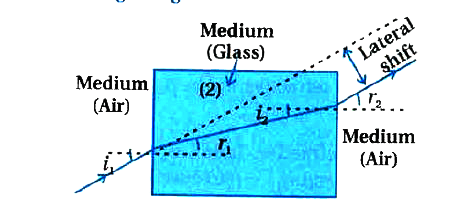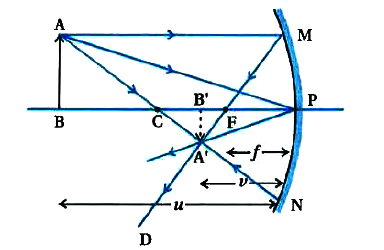Explain lateral shift for the refraction from rectangular glass slab.
 Solution in Gujrati
Solution in Gujrati
For a rectangular slab, refraction takes place at two interfaces (air-glass and glass-air).
It is easily seen from figure that r2=i1. i.e., the emergent ray is parallel to the incident ray there is no deviation but it does suffer lateral displacement/shift with respect to the incident ray.
Here, emergent ray is parallel to incident ray hence i1=r2. Thus, there is no deviation of incident ray but it experiences the lateral shift as compared to incident ray.
For more information :
If lateral shift is x, then
x=t×i2(1−n1n2)
where t = thickness of slab
n1 = refractive index of rarer medium (air)
n2 = refractive index of denser medium (glass)
i1 = incidence angle
Topper's Solved these Questions
- BOOK - KUMAR PRAKASHANCHAPTER - RAY OPTICS AND OPTICAL INSTRUMENTSEXERCISE - SECTION - A (TRY YOURSELF)74videos
RAY OPTICS AND OPTICAL INSTRUMENTS
- BOOK - KUMAR PRAKASHANCHAPTER - RAY OPTICS AND OPTICAL INSTRUMENTSEXERCISE - SECTION-B (NUMERICALS)(NUMERICAL FROM TEXTUAL ILLUSTRATIONS)17videos
RAY OPTICS AND OPTICAL INSTRUMENTS
- BOOK - KUMAR PRAKASHANCHAPTER - MOVING CHARGES AND MAGNETISMEXERCISE - SECTION D (MCQs ASKED IN COMPETITIVE EXAMS)34videos
MOVING CHARGES AND MAGNETISM
- BOOK - KUMAR PRAKASHANCHAPTER - SAMPLE QUESTION PAPER EXERCISE - PART-B SECTION-C5videos
SAMPLE QUESTION PAPER
Similar Questions
Give range of wavelength of visible light.
03:26View SolutionSuppose that the lower half of the concave mirror.s reflecting surface as shown in figure is covered with an opaque (non-reflective) material. What effect will this have on the image of an object placed in front of the mirror ?
 02:39View Solution
02:39View SolutionElectric charge Q having mass M moves on a circular path of radius R with velocity →v, perpendicular to uniform magnetic field B. When a particle completes one revolution, work done by the field is _______
02:04View SolutionTwo charges –q and +q are located at points (0, 0, –a) and (0, 0, a), respectively.
(a) What is the electrostatic potential at the points (0, 0, z) and (x, y, 0) ?
(b) Obtain the dependence of potential on the distance r of a point from the origin when r/a>>1 .
(c) How much work is done in moving a small test charge from the point (5,0,0) to (–7,0,0) along the x-axis? Does the answer change if the path of the test charge between the same points is not along the x-axis?02:20View SolutionFrom the course of a ray of light through a rectangular glass slab, explain what is lateral displacement and net deviation?
03:26View SolutionA ray of light is incident at an angle of 45∘ on one face of a rectangular glass slab of thickness 10cm and refractive index 1.5. Calculate the lateral shift produced.
03:11View SolutionA ray of light is incident at an angle of 60∘ on one face of a rectangular glass slab of thickness 0.1m, and refractive glass slab of thickness 0.1m, and refractive index 1.5. Calculate the lateral shift produced.
41:24View SolutionA ray of light is incident at an angle of 45∘ on one face of a rectangular glass slab of thickness 10cm and refractive index 1.5. Calculate the lateral shift produced.
View SolutionA ray of light is incident at an angle of 60∘ on one face of a rectangular glass slab of thickness 0.1m, and refractive index 1.5.Calculate the lateral shift produced.
03:01View Solutionकाँच के आयताकार गुटके (स्लैब) से अपवर्तन को समझाइए।
04:25View SolutionShift from a Glass Slab
03:34View SolutionRefraction through a Rectangular Glass Slab
02:39View SolutionA light enters a glass slab of thickness t with angle of incidence i suffers lateral shifts(s).If angle of refraction of light is r , then lateral shift is equal to
View SolutionLateral shift produced by a glass slab is X. When the slab is immersed in a liquid for the same incident ray lateral shift produced will be
03:26View SolutionA light enters a glass slab of thickness t with angle of incidence i suffers lateral shifts(s).If angle of refraction of light is r , then lateral shift is equal to
02:54View Solution

